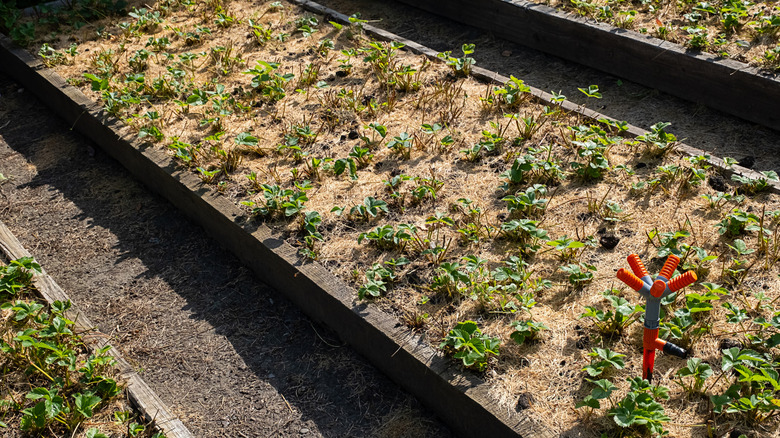The Secret To Caring For Your Strawberry Plants After Harvest
You've just enjoyed a sweet summer strawberry harvest after working hard to care for your crop in the spring. While your plants are finished fruiting, you're not done with strawberry care quite yet. Some gardeners assume their strawberries (Fragaria ananassa) are tough enough to survive the winter, while others don't realize that strawberries are perennial plants you can enjoy year after year.
Strawberries are perennial down to zone 5, but very harsh winter conditions can damage and even kill these plants. Properly overwintering your strawberries sets them up to thrive — not just survive — whether they're in-ground or potted plants. If you want your strawberry plants to continue producing fruit next season, it's not too late to prepare them for the coming winter. Winter preparations should begin in the fall and continue through the cold season. By following these steps, you can ensure you have the best, most plentiful harvest of strawberries for next year.
How to care for your strawberry plants after harvest
You should start preparing for winter between late August and early September, depending on your growing zone. At this point, you can stop fertilizing your plants. They're no longer using up energy and nutrients like they were during the growing season, but instead conserving them for dormancy. You'll know your strawberries are entering dormancy when they begin producing less foliage. You can also choose to prune dead foliage at this stage, but be sure not to cut back healthy stems.
In-ground strawberry plants will need a generous layer of mulch to stay warm. Wait until your nighttime temperatures dip below freezing consistently before doing this. The best types of mulch to help your strawberry plants thrive are straw, pine needles, and shredded leaves. After significant freezes and winter storms, you'll want to check on your strawberries and reapply mulch as needed.
Overwintering potted strawberry plants is trickier. It's harder to keep warm because they lack in-ground insulation. Bringing them indoors is the best option if you can. If that's not possible, you have other options for winterizing your strawberries. You can wrap blankets around the pots to provide insulation, as well as adding mulch to the soil's surface. If possible, placing pots against a wall can also help protect them from wind exposure.

